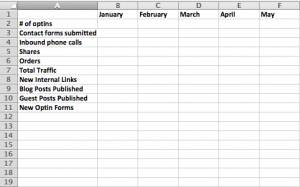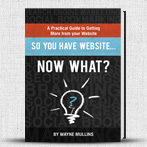Six Simple Steps to Radically Improve your Website Performance
Let’s cut to the chase – if your website were an employee you would have fired it long ago!
You’ve invested time, money, and effort into getting your website to perform better – and yet it’s still not pulling its own weight.
Nothing can be more frustrating!
Most entrepreneurs end up bouncing from idea to idea and strategy to strategy, hoping and praying something will work. Unfortunately, this approach is rarely successful.
Here are six steps to ensure your website improves its performance:
Step 1 – Establish Website Benchmarks
How is your website currently performing? Terribly? Okay, how terrible is it? What indicators are you using to determine how your website is performing?
One of the simplest, yet most effective way is to use analytics. By utilizing a tool like Google Analytics you’ll be able to establish baseline measurements in all of the key areas.
Warning: Most people assume the number of visitors to their website is the most important metric. This is a huge mistake. Traffic comes and traffic goes. Your most important metrics should be centered on conversions.
What is considered a conversion? Great question!
A conversion is when a visitor to your website takes a desired action that you want.
Here are a few conversion metrics.
Each month, how many people:
-Submit their name and email address
-Fill out a contact form
-Pick up the phone and call
-Share your page or your information
-Place an order
Conversion tracking through Google Analytics can automatically keep track of conversions for you. You simply need to install a little code on each of your thank you pages – and Google will do the rest.
Once you’ve identified the benchmarks you’re going to use, it’s now time to develop a strategy for your website.
Step 2 – Develop a Website Strategy
Sadly, the website strategy embraced by most entrepreneurs is what I refer to as the shotgun strategy. They take a few ideas, stick them together and then shoot them out hoping that at least one of them hits their target.
Like a shotgun, this strategy can work, but only if your target is really close. If you’re going to succeed on the web, it’s important that your strategy has much more of a long-term perspective.
Here’s how to develop a website strategy:
A) Survey what your most successful competitors are doing:
-Do they blog? If so, how often?
-Do they sell directly on their website?
-Do they do guest blog posts on other sites?
-Do they use PPC?
-Do they use re-targeting?
B) Based on the benchmarks you establish, what will your benchmarks look like 12 months from now? Each month, how many people:
-Submit their name and email address
-Fill out a contact form
-Pick up the phone and call
-Share your page or your information
-Place an order
Now that you have your current benchmarks and you’ve established what you want your benchmarks to be in 12 months, it’s now time to develop the specific tactics you’ll use.
Step 3 – Develop tactics for your website
Of the six steps required to radically transform your website in 12 months or less, this is the one most entrepreneurs get hung up on.
Fortunately, turning your website’s annual goals into specific tactics doesn’t have to be difficult. Actually, it’s quite simple when you remember that all you need to do is reverse engineer each goal established in your website strategy.
Let take a look at how easy developing tactics for your website can be – using this example.
Part of your strategy is to increase the number of opt-ins from 12 to 120 per month. Seems like a good solid goal, right!? What are some specific steps you could take over the next 12 months to help you reach this goal? Here are a few ideas:
-Add additional opt-in forms throughout the website
-Test different headlines on opt-in forms
-Guest blog post on other sites to drive additional traffic back the website
-Test additional opt-in offers/bonuses
-Revise the opt-in sequence to ensure readership
-Share the opt-in offer via social media
-Add additional internal links to keep visitors on the site longer and thereby increase their likelihood of opting in
Pretty simple, right!? When developing your tactics, avoid the temptation to spend a lot of time trying to figure out which order you should do things in. That will come in the next step.
Step 4 – Establish Quarterly/Monthly Goals for your Website
Now with benchmarks, strategy and tactics in hand, it’s time to turn them into measurable quarterly goals. Your benchmarks tell you where you are. Your strategy tells you where you’re going. And your tactics provide you with the specifics steps required to get there.
Now in this step you’re going to bring all three of these components together and establish quarterly goals for your website. Here are the steps required to do this:
1) Cluster your strategy and tactics to make it a little easier to organize them. Using the example above, you want to place everything relating to increasing opt-ins a cluster. And you’d do the same for each of the other major strategies you’re pursuing.
2) Organize each cluster in order of priority. If you’re working on the increase opt-ins cluster, then you want to make sure you start with the easiest tactic first.
3) Make sure each of the tactics is measurable. For example, to increase your number of opt-ins you’re going to share your option offer via social media, so you need to turn that into a measurable goal. *Each month I’m going to share my opt-in offer will all three of my social media channels.*
4) Now look at all of your clusters and break them down into monthly goals. This will take a little time, but that’s okay, because this is the step that will ensure your success.
Look across all of your clusters and rank them in priority order. For example, increasing traffic is priority number one, increasing opt-ins is priority number two, increasing sales is priority number three, etc.
Now ask yourself, “Can I work on any of these clusters simultaneously?” The answer will likely be yes. However, if your answer is no, all you need to do is take your total number of clusters and divide by 12 and that will show you how long you have to work on each cluster.
If you have 12 clusters, for example, then you will simply work on one cluster each month for the year. If you have six clusters, then you will work on each cluster for two months.
However, if you are able to work on multiple clusters at one time, then you will want to split the clusters into sections. Here’s what they may look like:
Month 1 Strategy:
-Create a master list of additional sites available for guest posts
-Learn how to find high volume low competition keywords
-Complete keyword research for each blog post (prior to publishing)
-Publish one blog post per week
-Promote all posts via social media channels
-Add 10 internal links to existing posts
-Begin tracking phone calls – asking how they heard about your business
Month 2 Strategy:
-Complete and submit one guest blog post
-Test two new opt-in offers on the site (one in the footer and one in the right column)
-Publish one blog post per week
-Promote all posts via social media channels
-Add 10 internal links to existing posts
You want to continue this process until you’ve gone out into the future 12 months. These goals will become your road map. It’s inevitable that life will get hectic at various points during the year and without solid quarterly and monthly goals it’s easy to get side-tracked.
Step 5 – Monitor your website’s performance each month
As we discussed in Step 1, your most important metrics should be centered on conversions. Step 5 will help keep you focused on the right metrics for your website.
Each month during the 12 months you will want to update your metrics. The simplest way I’ve found to do this is using an Excel spread sheet. Here is an example:
Pro Tip: Schedule an appointment with yourself for the same day and time each month to review and update your key metrics.
Don’t get discouraged if the metrics fall for a month or even a few months. Remember this is a long-term strategy and it will work if you stick with it.
Step 6 – Quarterly Performance Review
The final step in the process of radically improving your website’s performance in 12 months or less is to schedule time to complete a quarterly review.
Once a quarter, schedule a half day (3 – 4 hours) to review your benchmarks and look at what percentage of your monthly goals you’ve been hitting. With this information in hand you’ll be able to decide if your goals for the next quarter need to altered.
Of the six steps, this is the one most people try to skip – which is a HUGE mistake. Without spending the time to review your goals each quarter, you have no way of knowing whether or not your goals are leading you in the right direction. You won’t know if you need to get more intense with your goals or if you need to slack-off a bit.
Simply put, don’t skip out on your website’s quarterly performance review.
Conclusion
Don’t allow your website to continue down its path of poor performance. It’s time that you make it start carrying its own weight. Follow these six simple steps and you’ll radically improve your website in 12 months or less. It’s amazing how much progress can be made once you shift your focus from meaningless data to benchmarks that drive conversions.
What’s the biggest obstacle preventing your website from reaching its full potential?
Enjoy this post? Do me a favor and click here to share it on Facebook, or here to share it on Twitter.
- Likes, Shares, & Comments WON'T Put Money In Your Bank Account.
- In Our Free Course: Crush It On Facebook In 30-Days Or Less
- You'll Discover: A Simple Facebook Strategy We Used To Take a Client From Losing $10k Each Month To Making Thousands...In Only 86 Days.
- The 3-Step Formula We Used To Increase Another Client's Sales By Over $9,000 per Month (and they're spending less than $400 per month on Facebook Ads)





